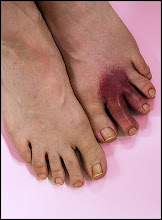Panasonic Lumix DMC-LX1
View PhotoThe LX1 (sold by Leica as the Leica D-LUX 2) is eminently portable. Portable? It's minuscule, smaller than my S80 – I wouldn't be able to get a grip on anything tinier. As it is I can manage, but I'm careful to use the wrist strap. (The user's manual recommends a vertical grip in which the shutter's released by your thumb!)
A few other annoyances come to mind. The lens cap fits and grips nicely – it's spring-loaded – but it's a plain old detachable cap, as used by Nièpce and Fox Talbot. It could easily get lost. (It comes with a spider-web tether, but I wanted a camera, not a charm bracelet.) I guess the engineers wouldn't complicate their design with extra mechanicals: optics first. That's typical of Leica, whose name is on the lens.
It's worthy of the name. I don't know the details of the Vario-Elmarit, but somehow the lens looks realer than the usual run of P&S lenses. You can even see a minute six-bladed iris diaphragm inside. The lack of an integral lens cap adds to the impression of a scale-model pro lens. Images are excellent, without the blurred corners at 28mm (equivalent) that mar the S80. There's no danger of mistaking LX1 photos for Summicron work, but the little zoom's sharp and contrasty, and doesn't vignette enough to matter.
As I said, I shoot in raw mode only. That slows me down, since it takes the Lumix three or four seconds to write a raw image to a fast SD card. Together with the lack of a finder, this prevents speedy operation. I don't mind, since I didn't get the cam to photograph sports or children. In fact, I rather enjoy composing on the LCD, which I use the way I would a bright ground-glass focusing screen – a small one, so I have to wear reading glasses and hold the LX1 at arm's length like a book.
I leave the display set on black and white at the 16:9 aspect ratio. (Panasonic brags about its wide-screen format.) Raw mode ignores the B&W setting as well as the aspect ratio. You always get full color and full 16:9 sensor size. I don't mind cropping or converting to B&W in Photoshop.
PS and PS plugins are all the software I've used with the LX1. I haven't even looked at the disk that came in the box.
The camera got panned, in most reviews, for noisy capture. I bought mine after downloading sample photos and tweaking them in PS. That convinced me I can turn the noise to my advantage – time will tell. If you buy one of these cameras, be prepared for a lot of chroma noise. The anti-shake mechanism helps, especially if, like me, you shoot mainly static scenes. I can shoot ISO 80 where I'd expect to need 320, since slow shutter speeds are holdable. Alas, no stabilizer can cure motion on the part of the subject, so snapshots of kids and cats and such aren't in the cards.
Black-and-white hides much of the noise. I don't see how anyone could tolerate the camera for color, where the blotchiness is jarring, especially with dark subjects. And most especially with dark blues. ISO 400 is pretty hopeless even with postprocessing; it shows a kind of streaking in areas of flat color.
The controls are well thought out, with those most used tied to buttons and switches, not menus. (True, I have to use a fingernail to push the buttons). The camera has nearly every trick I need. Today, for example, I made a photo of a colleague in her dark, cluttered office, with one bright desk lamp for illumination. I spot-metered from the bright areas, then fine-tuned that with exposure compensation. (Yup, there's a live histogram.) Result was an exposure of 1/8 sec at ISO 80, which I was able to handhold with the help of IS. ("Image Stabilization," for those who don't know what the meaning of IS is.)
You can see my first week's results of shooting with the LX1 here.
Afterthoughts in the wake of a weekend spent with the LX1 in Washington, DC.
- As with other LCD-only P&S cams, this one's nearly useless outdoors in bright sun. It does feature a one-button brightener for the LCD, but that doesn't help much. Point-and-shoot takes on a very literal meaning.
- The IS works well. Indoors I found myself generally leaving the camera set at f/2.8 and ISO 80, holding my breath and hoping for the best. And the best is often what I got.
- In photographing people or anything else animate, the slow (three-second) write-to-memory time is limiting. (I use RAW; JPG would be faster.)

